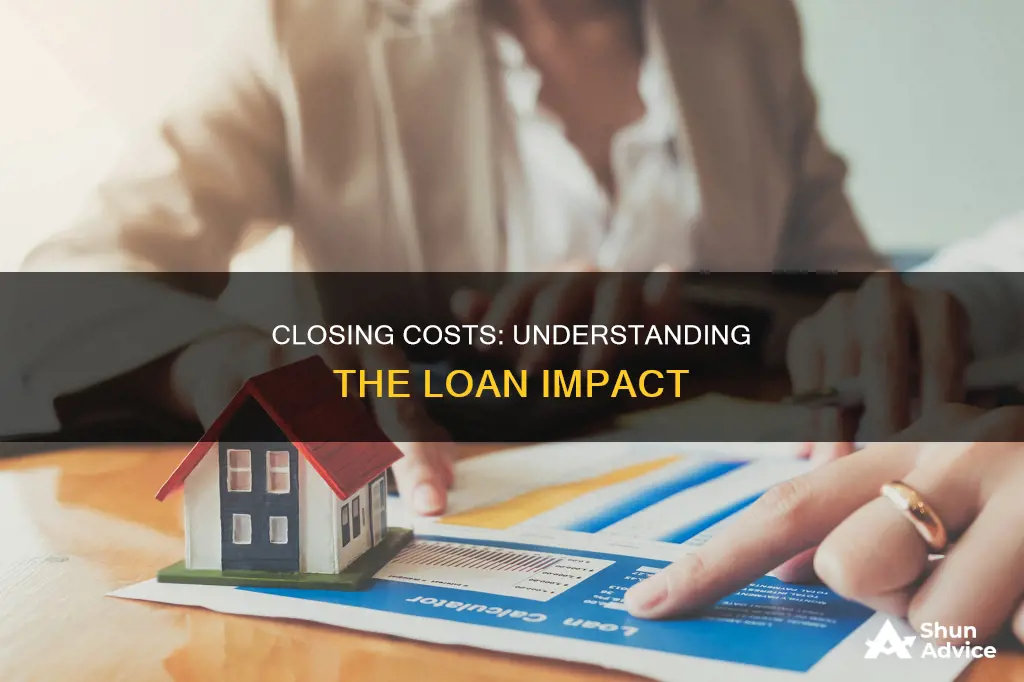
Closing costs are all the expenses and fees paid by a buyer to purchase a home, including costs for underwriting and processing the mortgage, third-party fees paid to a home appraiser and property inspector, and prepaid expenses such as property taxes and insurance. Closing costs can be paid out of pocket, but they can also be included in the loan amount. Some lenders will let you roll closing costs into your home loan, but that will likely increase your loan amount and your interest rate.
| Characteristics | Values |
|---|---|
| Closing costs | 3%–6% of the loan amount |
| Who pays the closing costs | The buyer |
| When are closing costs paid | When you sign your final loan and purchase documents at closing |
| Can closing costs be included in the loan balance | Yes, but it will increase the loan amount and interest rate |
| Can the seller contribute to closing costs | Yes, but the contribution is limited to 3% of the loan value |
| Can closing costs be avoided | Yes, with a no-closing-cost loan |
What You'll Learn

Lenders may offer a credit to include closing costs in the loan amount
Closing costs can add up to thousands of dollars, and some lenders may offer a credit to include these costs in the loan amount. This is known as a "pricing premium" in the lending industry. This option is ideal for those who cannot afford to pay a large sum upfront. However, it is important to note that this will result in a higher interest rate or a larger loan balance.
For example, let's consider a scenario where the closing costs on an $80,000 mortgage are $3,000, and the fixed interest rate is 4%. The lender may offer a closing cost credit of 1% of the mortgage amount, which is $800. As a result, your interest rate will increase to 4.125%. In this case, your monthly mortgage payment without the closing cost credit would be $382, while with the credit, it would be $392.
The benefit of including closing costs in the loan amount is that you can preserve liquidity and avoid paying a large sum upfront. However, it is essential to consider the long-term implications. By choosing this option, you will end up paying more over the life of the loan due to the higher interest rate or increased loan balance. Therefore, it is crucial to weigh your short- and long-term financial goals before making a decision.
Additionally, it's worth noting that closing costs can vary depending on the lender, loan type, loan terms, the amount borrowed, down payment, interest rate, location, and homeowners insurance. These costs typically range from 2% to 6% of the total loan amount. Before making a decision, it is advisable to compare different lenders' offers and understand how including closing costs will affect your loan-to-value ratio and debt-to-income ratio.
Chevy's Loaner Vehicle Offer: What You Need to Know
You may want to see also

Closing costs can be paid out-of-pocket
While paying closing costs out-of-pocket can be a substantial expense, it is an option that allows you to keep more cash on hand. It is important to note that closing costs are not just paid by the buyer; both buyers and sellers typically pay closing costs, and these costs can vary depending on factors such as the price of the home, the type of mortgage, and the state in which the property is located. For example, attorney fees are common closing costs, but whether these are paid by the buyer or seller depends on state law. In some states, a real estate attorney must be present for the transaction to close, and the associated fees are usually paid by the buyer.
If you are unable or unwilling to pay closing costs out-of-pocket, there are alternative options available. Some lenders may offer to include closing costs in the total loan amount, but this will likely result in a higher interest rate or a larger loan balance. For example, if you have an $80,000 mortgage with $3,000 in closing costs and a fixed interest rate of 4%, including the closing costs in the loan amount may increase your interest rate to 4.125%. While this option can reduce the upfront costs, it will result in higher monthly mortgage payments over the life of the loan.
Another option is to negotiate with the seller for a "seller concession," where the seller pays some or all of the closing costs. However, the seller will usually require you to pay a higher price for the home to cover these additional costs. Additionally, certain lenders and realty teams offer loans with zero or reduced closing costs, waiving or covering many of the traditional closing costs for home purchase and refinance loans. These options can help reduce the upfront costs associated with buying a home, but it is important to carefully consider how these choices will impact your short- and long-term financial goals.
ChexSystems and Loans: What You Need to Know
You may want to see also

Closing costs are usually 3-6% of the loan amount
Closing costs are the expenses and fees paid by a buyer to purchase a home. They include costs for underwriting and processing the mortgage, third-party fees paid to a home appraiser and property inspector, and prepaid expenses such as property taxes and insurance.
Closing costs can add up quickly and are typically 3-6% of the loan amount, although this can vary depending on the type of loan and the location of the property. For example, USDA loans allow for up to 6%, while VA loans have a maximum of 4%. The closing costs for a buyer usually run between 3% and 4% of the loan amount. So, for a loan amount of $80,000, closing costs would normally range between $2,400 and $3,200.
Some lenders may offer a credit that can be used to include closing costs as part of the total loan amount, but this will result in a higher interest rate. This is known as a "pricing premium" in the lending industry. For example, if your closing costs on an $80,000 mortgage are $3,000 and the fixed interest rate is 4%, the interest rate may increase to 4.125% in exchange for a closing cost credit of $800.
Including closing costs in the loan amount can be beneficial for buyers who want to keep more cash on hand, especially if they are also making a large down payment. However, it is important to note that this will result in paying more interest over time. Additionally, including closing costs in the loan amount can increase the loan-to-value ratio, lowering the amount of equity in the home.
Discharging Educational Loans: Chapter 7 Bankruptcy Explained
You may want to see also

Some closing costs are paid by third-parties
Closing costs are the associated fees and expenses paid when a real estate transaction closes. They are usually paid at the closing of a real estate transaction, which is the final step in the buying or selling process. Closing costs can be paid by the buyer, the seller, or a third party.
Third-party fees are incurred during the mortgage process and are paid to a home appraiser and property inspector. They can also include prepaid expenses such as property taxes and insurance. These third-party fees can be paid by the buyer, the seller, or a third party.
For example, if you are buying a property with an $80,000 mortgage, your closing costs could be between $2,400 and $3,200. In this case, the seller could pay up to $6,000 towards closing costs if you make a down payment of less than 10%. If your closing costs are less than 3% of your loan value, the seller can contribute up to 100% of the closing cost value.
Some lenders may offer a credit that can be used to include your closing costs as part of the total loan amount, but this will result in a higher interest rate. This is known as a "pricing premium" in the lending industry. For example, if your closing costs on an $80,000 mortgage are $3,000 and the fixed interest rate is 4%, you may be offered a closing cost credit of 1% of the mortgage amount ($800) in exchange for an increase in your interest rate to 4.125%.
Chatham Community Library: Interlibrary Loans Available?
You may want to see also

Closing costs can be rolled into the loan
While some lenders may allow you to roll closing costs into your home loan, this will likely increase both your loan amount and interest rate. This option may be suitable if you don't want to pay a large lump sum at closing and can manage higher monthly mortgage payments. For instance, if you're taking advantage of lower interest rates or if your total loan amount is within the bank's limits, rolling closing costs into your loan may be feasible.
However, it's important to note that you'll generally pay more in the long run due to higher interest rates or a larger loan balance. Therefore, it's advisable to carefully consider how a no-closing-cost loan would impact your short- and long-term financial goals. You can request estimates from lenders for both zero-closing-cost loans and loans with upfront closing fees to make an informed decision.
Additionally, you can explore alternatives to paying closing costs out of pocket, such as negotiating a "seller concession" with the seller, where they pay a portion of the closing costs, or a "pricing premium" with your lender, where they cover the closing costs in exchange for a higher interest rate.
Checksmart's Title Loan Services: What You Need to Know
You may want to see also
Frequently asked questions
Yes, some lenders will let you roll closing costs into your home loan. However, this will likely increase your loan amount and interest rate.
Closing costs are typically between 2% and 6% of the loan amount. For example, if you’re taking out a loan worth $200,000, the closing costs would normally range between $4,000 and $12,000.
Closing costs include fees for underwriting and processing the mortgage, third-party fees paid to a home appraiser and property inspector, and prepaid expenses such as property taxes and insurance.
You can ask the seller to pay a portion of the closing costs to reduce your upfront expenses. You can also shop around for certain services like appraisals, inspections, and title insurance to find competitive rates and potentially save on these costs.







